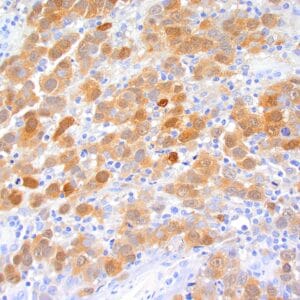| Weight | 1 lbs |
|---|---|
| Dimensions | 9 × 5 × 2 in |
| host | mouse |
| isotype | IgG2b |
| clonality | monoclonal |
| concentration | concentrate, predilute |
| applications | IHC |
| reactivity | human |
| available size | 0.1 mL, 0.5 mL, 1 mL concentrated, 7 mL prediluted |
mouse anti-SOX-2 monoclonal antibody (ZM57) 6367
Price range: $160.00 through $528.00
Antibody summary
- Mouse monoclonal to SOX-2
- Suitable for: Immunohistochemistry (formalin-fixed, paraffin-embedded tissues)
- Reacts with: Human
- Isotype:IgG2b
- Control: Normal brain tissue and astrocytoma
- Visualization: Nuclear
- 0.1, 0.5, 1.0 mL concentrated, 7 mL prediluted
mouse anti-SOX-2 monoclonal antibody ZM57 6367
| target relevance |
|---|
| Protein names Transcription factor SOX-2 |
| Gene names SOX2,SOX2 |
| Mass 34310Da |
| Function FUNCTION: Transcription factor that forms a trimeric complex with OCT4 on DNA and controls the expression of a number of genes involved in embryonic development such as YES1, FGF4, UTF1 and ZFP206 (By similarity). Binds to the proximal enhancer region of NANOG (By similarity). Critical for early embryogenesis and for embryonic stem cell pluripotency (PubMed:18035408). Downstream SRRT target that mediates the promotion of neural stem cell self-renewal (By similarity). Keeps neural cells undifferentiated by counteracting the activity of proneural proteins and suppresses neuronal differentiation (By similarity). May function as a switch in neuronal development (By similarity). {ECO:0000250|UniProtKB:P48430, ECO:0000250|UniProtKB:P48432, ECO:0000269|PubMed:18035408}. |
| Subellular location SUBCELLULAR LOCATION: Nucleus speckle {ECO:0000250|UniProtKB:Q05066}. Cytoplasm {ECO:0000250|UniProtKB:Q05738}. Nucleus {ECO:0000250|UniProtKB:Q05738}. Note=Acetylation contributes to its nuclear localization and deacetylation by HDAC3 induces a cytoplasmic delocalization (By similarity). Colocalizes in the nucleus with ZNF208 isoform KRAB-O and tyrosine hydroxylase (TH) (By similarity). Colocalizes with SOX6 in speckles. Colocalizes with CAML in the nucleus (By similarity). Nuclear import is facilitated by XPO4, a protein that usually acts as a nuclear export signal receptor (By similarity). {ECO:0000250|UniProtKB:Q05066, ECO:0000250|UniProtKB:Q05738}. |
| Structure SUBUNIT: Interacts with ZSCAN10 (By similarity). Interacts with SOX3 and FGFR1 (By similarity). Interacts with GLIS1 (PubMed:21654807). Interacts with POU5F1; binds synergistically with POU5F1 to DNA (By similarity). Interacts with DDX56 (By similarity). Interacts with L3MBTL3 and DCAF5; the interaction requires methylation at Lys-42 and is necessary to target SOX2 for ubiquitination by the CRL4-DCAF5 E3 ubiquitin ligase complex (PubMed:30442713). Interacts with RCOR1/CoREST (By similarity) (PubMed:30442713). Interacts with PHF20L1; the interaction requires methylation at Lys-42 and Lys-117 and protects SOX2 from degradation (PubMed:29358331). Interacts with TRIM26; this interaction prevents ubiquitination by WWP2 (PubMed:34732716). {ECO:0000250|UniProtKB:P48432, ECO:0000269|PubMed:21654807, ECO:0000269|PubMed:29358331, ECO:0000269|PubMed:30442713, ECO:0000269|PubMed:34732716}. |
| Post-translational modification PTM: Sumoylation inhibits binding on DNA and negatively regulates the FGF4 transactivation. {ECO:0000250}.; PTM: Methylation at Lys-42 and Lys-117 is necessary for the regulation of SOX2 proteasomal degradation. {ECO:0000269|PubMed:29358331, ECO:0000269|PubMed:30442713}.; PTM: Ubiquitinated by WWP2, leading to proteasomal degradation. {ECO:0000269|PubMed:34732716}. |
| Domain DOMAIN: The 9aaTAD motif is a transactivation domain present in a large number of yeast and animal transcription factors. {ECO:0000250|UniProtKB:P41225}. |
| Biotechnology BIOTECHNOLOGY: POU5F1/OCT4, SOX2, MYC/c-Myc and KLF4 are the four Yamanaka factors. When combined, these factors are sufficient to reprogram differentiated cells to an embryonic-like state designated iPS (induced pluripotent stem) cells. iPS cells exhibit the morphology and growth properties of ES cells and express ES cell marker genes. {ECO:0000269|PubMed:18035408}. |
| Involvement in disease DISEASE: Microphthalmia, syndromic, 3 (MCOPS3) [MIM:206900]: A disease characterized by the rare association of malformations including uni- or bilateral anophthalmia or microphthalmia, and esophageal atresia with trachoesophageal fistula. Microphthalmia is a disorder of eye formation, ranging from small size of a single eye to complete bilateral absence of ocular tissues (anophthalmia). In many cases, microphthalmia/anophthalmia occurs in association with syndromes that include non-ocular abnormalities. {ECO:0000269|PubMed:12612584, ECO:0000269|PubMed:24033328}. Note=The disease is caused by variants affecting the gene represented in this entry. |
| Target Relevance information above includes information from UniProt accession: P48431 |
| The UniProt Consortium |
Data
 |
| Human skin stained with anti-SOX-2 antibody using peroxidase-conjugate and DAB chromogen. Note the nuclear staining of keratinocytes.. |
Publications
| pmid | title | authors | citation |
|---|---|---|---|
| We haven't added any publications to our database yet. | |||
Protocols
| relevant to this product |
|---|
| IHC |
Documents
| # | SDS | Certificate | |
|---|---|---|---|
| Please enter your product and batch number here to retrieve product datasheet, SDS, and QC information. | |||
Only logged in customers who have purchased this product may leave a review.















Reviews
There are no reviews yet.